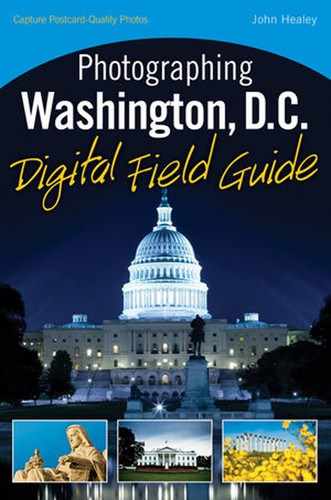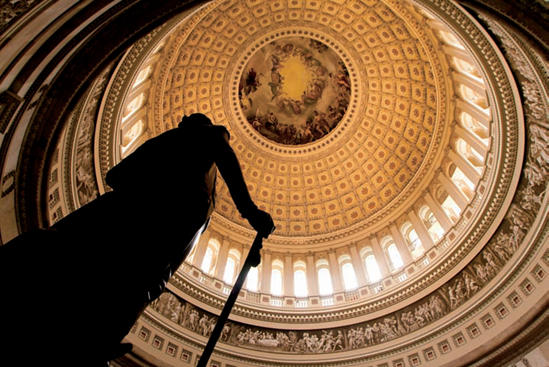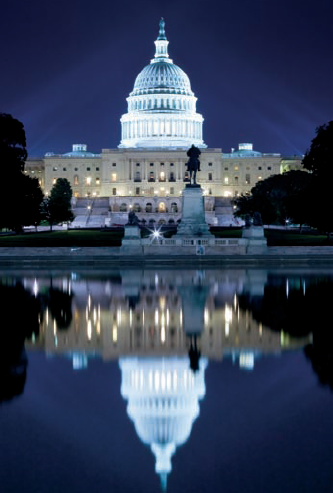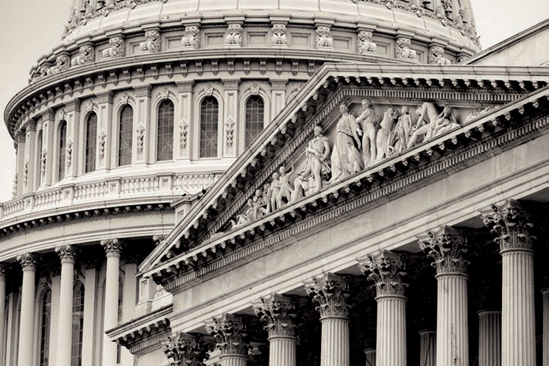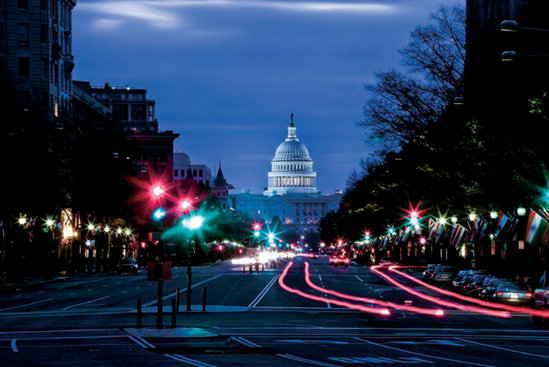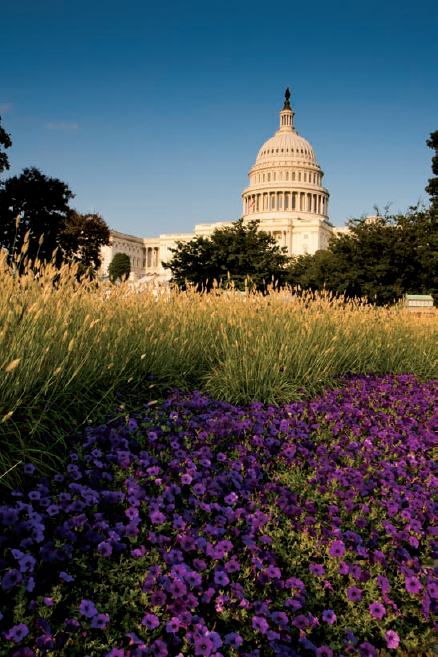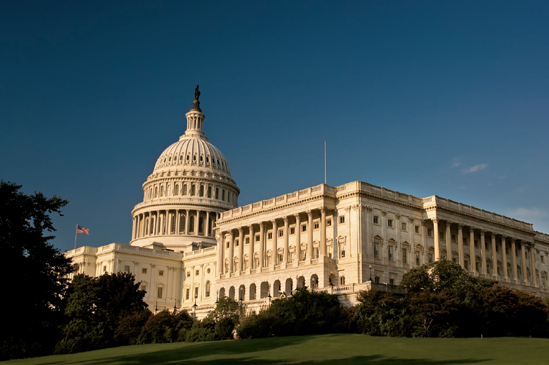
Looking northeast at the Capitol on an early summer evening. Taken at ISO 100, f/5, 1/200 second with a 45mm lens.
The most important building to the government of the United States is the Capitol. Beneath its massive dome, the United States Congress presides over the nation based on the powers given to it by the United States Constitution.
Public tours are relatively easy to join but proceed rather quickly, and for security reasons, the guides request that you stick near the main group at all times. Private tours, which U.S. residents can request from their Congressperson, usually require weeks, if not months, of advance planning but allow you more access and more time to photograph.
A photographer could literally spend weeks capturing the Capitol in all its glory. The suggestions in the next sections are some locations where you can begin your photographic tour. You will undoubtedly find some spots of your own as well.
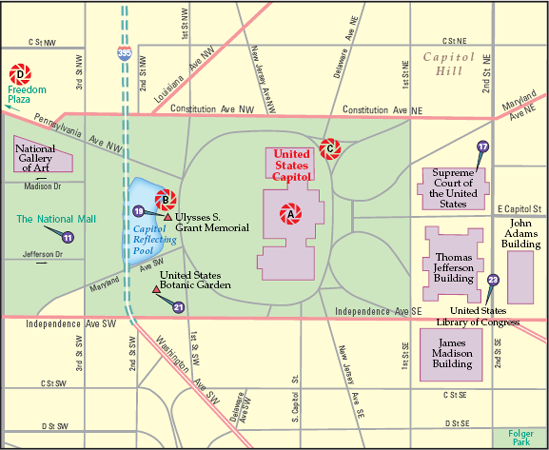
Figure 22.1. The best locations from which to photograph the Capitol: (A) the interior of the Rotunda, (B) the Capitol Reflecting Pool, (C) the northeast corner, and (D) Freedom Plaza (1.5 miles northwest). Nearby photo ops: (11) the National Mall, (17) Supreme Court of the United States, (19) Ulysses S. Grant Memorial, (21) United States Botanic Garden, and (23) United States Library of Congress.
Tip
Cameras are allowed in the main areas of the Capitol that you can visit, but if you are intending to visit the Galleries of the Senate and House, almost nothing is allowed to be carried into them.
Standing beneath the Capitol Dome is one of the best experiences a visitor can have when coming to Washington, D.C., and you may even consider booking a couple of tours to take it all in.
It's not easy to capture the grandeur of the Rotunda in a photograph. But one way to do so is to take a wide photo that features the swirling Rotunda with one of the statues in the foreground as shown in Figure 22.1. Because the Rotunda is so bright at the top, you can partially silhouette the statue below. The contrast of light and dark, along with the textures and colors creates a striking image.
Another good shot is to walk to the centermost area of the Rotunda (or as close as you can get given the crowds) and to photograph the dome on its own. The combination of light pouring through the windows along with the layered architectural and art details makes a photo that you'll just want to stare at for a while to take in. You can do this shot wide — capturing as much of the circular area as possible — or you can zoom in and focus on the details.
One of the coolest ways to photograph the Capitol is with its reflection in the Capitol Reflecting Pool on the building's west side during the evening or at night (see Figure 22.2). It's a popular spot and one that other tripod-toting photographers are seeking to get too.
Figure 22.2 was made by using a small table-top tripod sitting on the lip of the reflecting pool, which makes for an interesting, low vantage point. Small table-top tripods are a great idea as they don't attract attention and are easy to carry. Also note that if the wind is low, the reflection will be clearer.
Personally, this view is one of my favorite views of the Capitol, especially in black and white as in Figure 22.3. It's majestic and full of patterns, textures, light, and shadow. This view reveals the intricate and stately manner of the Capitol.
An interesting shot that captures more of a city feel can be made from Freedom Plaza, just north of Pennsylvania Avenue downtown (see Figure 22.4). Actually, if Pennsylvania Avenue continued uninterrupted, it would go straight through the plaza, so here you have the nice opportunity of being in the middle of the road while not having to deal with any traffic. It's a nice view down a historic avenue, and it's a great view at night.
These photos of the Capitol require a variety of techniques, but from all these vantage points the shots can be made as simple or as technical as you want.
Because you may be packing lightly to enter the Capitol and take the tour, these shots can all be made with equipment that can fit into a bag sized at the requirements mandated by Capitol security.
For Rotunda images (refer to Figure 22.1), you need wide lenses — the wider, the better. At minimum, you will need something between 20–24mm, but anything wider works well, too. For detail shots of the Rotunda, a lens between 60–70mm is a good choice. And of course you can use a longer focal length if you want to get very specific shots of some of the details.
The night shot with the Capitol Reflecting Pool (refer to Figure 22.2) can be made with a 65mm lens, but you can also shoot it wider or tighter depending on your preferences. Also, a vertical shot works as well, shooting tight in on the Capitol and its reflection.
The photo from the northeast corner of the Capitol (refer to 22.3) can be done in a variety of ways, but using a longer lens will compress the details of the building, leading to a layering effect. Using a wide-angle lens and getting closer often results in unpleasant distortion of the elements that make up the photograph.
For the shot looking down Pennsylvania Avenue shown in Figure 22.4, a 170mm lens or similar should work, but again this can be shot tighter if you choose to go for a different look.
For the northeast corner shot (refer to Figure 22.3), a graduated neutral density filter either on the camera or added in a photo-editing program (if your exposure is close) works. And if you have nice clouds and a blue sky, a polarizer will sharpen up the contrast of the sky nicely.
The key element of the many night shots is a table-top tripod. You can certainly use a standard-size tripod as well, but lugging one around can be a real pain and figuring out where you can and where you can't use a tripod is not all that easy. The table-top one goes basically unnoticed and is easy to take around; you can also use it to snap pictures of yourself or those traveling with you. Use your camera's self-timer to trip the shutter without causing camera shake or use a cable release.
When photographing the Rotunda, there's a good chance that the bright light of the windows will throw off your camera's exposure. Be prepared to increase the exposure by using your camera's exposure compensation function (if using an automatic mode) or, if using Manual mode, let the exposure meter go about 1/2 to 3/4 of a stop over normal. Doing so compensates for the brightness of the windows. Despite their brightness, it is still relatively dark here. Set your ISO between 400–800, depending on the amount of light at the time you are visiting.
The northeast corner photo is a pretty standard shot requiring no special settings. You can use Aperture Priority mode and adjust the aperture to f/5.6 or so to keep your subject in focus. (Remember that you get more depth of field farther from your focus point, so you want to focus on something closer to you rather than something that is farther away in the frame.) If the sun is shining directly, there is a chance that you'll need to add some exposure to the scene because the Capitol is white and some cameras might underexpose this scene.
If you are using Shutter Priority or Aperture Priority modes, you will have to test how well your camera will expose the night scenes — some will do this better than others. If you are using a tripod, you can go ahead and set a high f-stop value, such as f/16 or higher to ensure that everything is in focus. Cameras have different maximum exposure times though, so you may have to adjust your ISO or aperture to compensate for yours.
At the Capitol, no matter what time it is or where you are, you can take a good photo.
For shooting the Rotunda (refer to Figure 22.1), visiting during midday helps ensure that all the windows will be evenly illuminated. However, don't rule out afternoon or mornings — the transitioning light can work well to create something a little different.
The shot from the northeast (refer to Figure 22.3) is best done before noon, when the sun is on the east side of the building, but a backlit Capitol Building may offer a unique image as well.
Bad weather can be a great thing for photographs of the Capitol, especially during times when it's foggy or snowy. Rainy days can also make an atmospheric shot, so if your only time to shoot is during inclement weather, look at it as a good thing. Far fewer shots are made during this time, so you may be getting something very unique.
The Capitol dome glows brilliantly in low light (see Figure 22.5), and it stands out from amongst everything else, so at dusk and night there are many possibilities for great images.
If you are hand-holding night shots, try Shutter Priority mode and set a shutter speed that you can hand-hold without shaking your camera to avoid blurring the photo. Start off at 1/60 second and try a few photos at slower shutter speeds as well, going down to 1/15 second or even slower. Also, be sure to turn your flash off.
Inside the Capitol Visitor Center, you have the opportunity to photograph the model statue of the Statue of Freedom. Try doing so from the steps of the entrance area, using a longer lens. You can also do some tight portrait shots from next to her.
If you like photographing people, statues are actually good practice. You can find plenty of them in the Capitol Visitors Center.
Finally, the Capitol is set on many acres of land, and within those are trees, plants, and flowers that all can be nicely used as foreground elements in your photographs (see Figure 22.6). The west side in the spring and summer is especially good for such photographs.
